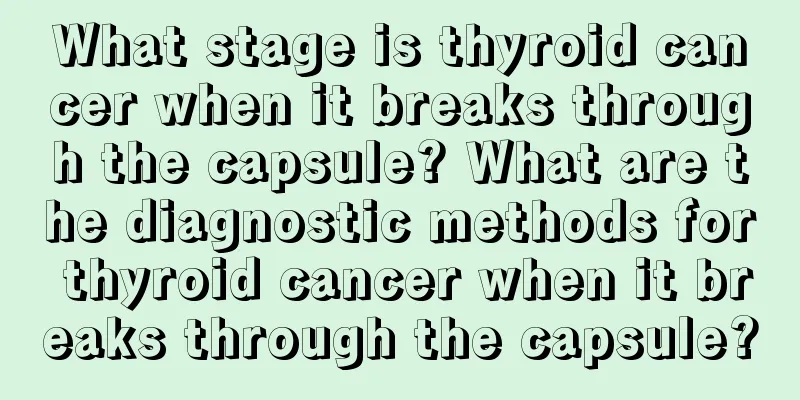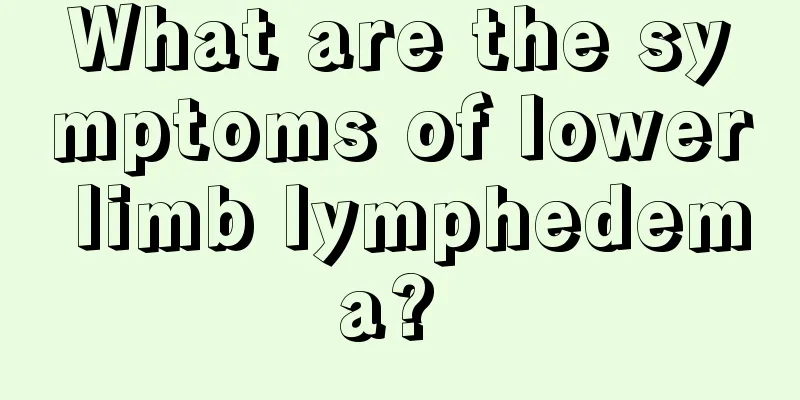What stage is thyroid cancer when it breaks through the capsule? What are the diagnostic methods for thyroid cancer when it breaks through the capsule?

|
What stage is it if thyroid cancer breaks through the capsule? If it has broken through the capsule, it is considered infiltration and there is a risk of metastasis, which means it has reached the late stage. Nowadays, people are most worried about their health problems, especially high-incidence diseases like thyroid cancer. The diagnosis and treatment of thyroid cancer has become a challenge that many hospitals need to face. So how to correctly understand the pathological diagnosis of thyroid cancer? Now let me introduce it to you. 1. Diagnosis of papillary thyroid microcarcinoma (PTMC) With the development of imaging, the detection rate of PTMC is getting higher and higher. Due to its small size, most of them can only be diagnosed under a microscope, so it is very easy to miss the diagnosis in the intraoperative frozen section diagnosis, which often brings a lot of trouble to the pathologists on duty. PTMC refers to papillary thyroid carcinoma with a diameter of ≤1cm, which is often close to the thyroid capsule and most of them have typical histological and cytological characteristics of papillary carcinoma. Smaller PTMC (30% of tumor cells have "shoe-nail" cell characteristics, that is, the tumor cell nucleus is located in the upper middle of the cytoplasm and protrudes toward the edge of the cavity, like a shoe-nail. Therefore, if these subtypes are present in PTMC, they should be included in the report to alert clinical attention and give appropriate treatment. There is still a lot of controversy about how to view such a small lesion, how to deal with it clinically, and what its prognosis is. For such a small lesion, most of which have a good prognosis, should it be called cancer? Should it be called atypical hyperplasia like atypical adenomatous hyperplasia of the lung? As far as current research is concerned, some studies have shown that PTMC should be surgically removed because of its high lymph node metastasis rate (16%-64%) and frequent multifocal occurrence. 2. Diagnosis of follicular thyroid lesions Thyroid follicular lesions are another difficult problem in morphological diagnosis, especially in intraoperative frozen section diagnosis, it is difficult to determine whether it is benign or malignant. In particular, microinvasive follicular carcinoma (MIFTC) is not only difficult to diagnose before surgery, but also difficult to diagnose even in postoperative paraffin sections. This is not only because its tumor cells often lack malignant characteristics, and the difference from adenoma is only the invasion evidence visible under the microscope: capsule and/or vascular invasion: but also because of capsule and vascular invasion, especially capsule invasion. There is still no unified diagnostic standard. The most clear capsule invasion is that the tumor breaks through the original capsule and invades the surrounding thyroid tissue. The diagnostic criteria for incomplete capsule infiltration vary greatly. Most people believe that the diagnosis can be made only when the tumor cells destroy the capsule perpendicular to the capsule fibers and infiltrate in a mushroom-like manner, and the depth of infiltration is greater than 2/3 of the capsule thickness, or even nearly the entire layer. However, some scholars believe that if the tumor infiltrates irregularly and destroys the fibrous capsule, it can be diagnosed even if it does not exceed half of the capsule thickness. In actual work, we often see follicular thyroid carcinoma metastasized to the bone or lung, and its morphology is very similar to the follicles of nodular goiter. Therefore, only when we know that it has metastasized, our diagnosis will be easy. It is much more difficult before surgery or before the metastasis is discovered. Therefore, MIFTC is not a disease that is diagnosed completely based on morphology, but a disease that is diagnosed mainly based on its biological behavior. Unfortunately, we still don’t know the fundamental mechanism of its biological behavior, and there is no effective way to diagnose this disease. In view of the current situation, some scholars have proposed that encapsulated well-differentiated follicular cell tumors with unclear papillary carcinoma nuclear changes, no vascular invasion, and no or uncertain capsular invasion should be called well-differentiated tumors of uncertain malignant potential (WDT-UMP); and that encapsulated well-differentiated follicular cell tumors without papillary carcinoma nuclear changes, with uncertain capsular invasion, and no vascular invasion should be called follicular tumors of uncertain malignant potential (FT-UMP). I believe that these names are more appropriate diagnoses for this type of lesions. In fact, capsular invasion without vascular invasion does not affect the patient's prognosis, while extensive vascular invasion has a worse prognosis than limited vascular invasion. Therefore, Japanese scholars proposed a new classification of thyroid follicular cell tumors: (1) Benign tumors, mainly follicular adenomas; (2) Borderline tumors refer to encapsulated tumors with or without papillary carcinoma-type nuclei, with or without microcapsular invasion, including encapsulated papillary carcinoma, encapsulated follicular subtype papillary carcinoma, well-differentiated tumors of uncertain malignant potential, follicular tumors of uncertain malignant potential, and follicular carcinoma with only capsule invasion. The above tumors should be classified as low-grade/well-differentiated follicular cell adenocarcinoma when there is lymph node metastasis; (3) Malignant follicular cell adenocarcinoma is further divided into: ① Low-grade/well-differentiated follicular cell adenocarcinoma, including invasive papillary carcinoma. |
>>: What are the symptoms of thyroid cancer recurrence? What should I do if thyroid cancer recurs?
Recommend
What medicine should I take for a slow heartbeat
A rapid heartbeat is called palpitations, and thi...
How to treat eye arteriosclerosis?
Of course, the treatment of ocular arterioscleros...
How to choose toothpaste
Brushing your teeth frequently is something that ...
What is the reason for the headache?
Modern people are under great pressure at work, s...
How to quickly and effectively cure small cell lung cancer
How to quickly and effectively cure small cell lu...
The functions and effects of Eucommia tea and contraindications
People who are familiar with the medicinal materi...
What kind of primer is good for summer? Teach you how to choose primer
There are many colors of isolation cream. Women s...
Is yellowing hair a disease?
There are many reasons for yellow hair. If you su...
Skin turns darker in autumn
Most female friends pay attention to sun protecti...
What causes sweating due to weakness
If the body always sweats, we should pay attentio...
I have no strength and my head feels dizzy
Sometimes people may find that they have no stren...
Can sugar help sober you up?
Nowadays, no matter what kind of meal you eat, yo...
What's wrong with my stomach ache
We often experience stomach pain in our daily liv...
How long does it take for anal pain to recover after radiotherapy for rectal cancer
The recovery time for anal pain after radiotherap...
How much is the cost of mid-term treatment for liver cancer?
The cost of mid-term surgery for liver cancer sho...









